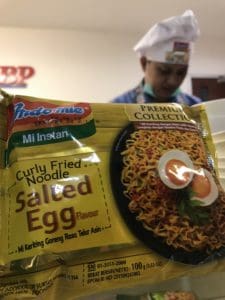As Black Sea wheat increasingly throws its bulk around in Australia’s main $2.5 billion wheat market, the Australian Export Grains Innovation Centre (AEGIC) is taking action to help the Australian industry preserve and increase value for Australian growers.
South East Asia accounts for almost half of all Australian wheat exports, the lion’s share of which is used for instant noodles and fresh yellow alkaline noodles.
It is crucial for Australia to understand the wheat quality requirements of South East Asian flour millers, and to continue meeting those needs in the face of mounting pressure from low cost competitors.
And when we talk about wheat quality for noodles, we mean looking good (noodle colour and colour stability) and feeling good (noodle texture and mouthfeel).
AEGIC wheat quality technical markets manager Dr Larisa Cato said previous AEGIC research had already confirmed noodle texture (firmness and elasticity), colour and colour stability were among the major factors that flour millers look for when making wheat purchasing decisions.
This research, a GRDC investment, involved collecting and analysing the wheat quality preferences of more than 250 flour milling staff in 40 flour mills across Indonesia, Vietnam, Thailand, Malaysia, Singapore and the Philippines.
“Thanks to this market insight, the Australian industry has a detailed understanding of what flour millers look for when buying wheat,” she said.
“We know Australian wheat has the best colour attributes for noodles, better than wheat from any other origin in the world. Whilst the noodle textural properties of our wheat are good, there is room for improvement.”
In the light of these findings, AEGIC is now focusing on enhancing the noodle textural qualities of Australian wheat.
“Noodle texture is related to mouthfeel – i.e. the balance of firmness and elasticity, and is unique to each noodle type and each market. AEGIC’s objective is to develop measurable texture targets for each of our wheat classes to support Wheat Quality Australia classification and wheat breeders in new variety development.”
Dr Cato said there was also an opportunity to further improve noodle appearance – i.e. noodle colour and colour stability.
“This will help widen the gap between Australian wheat and wheat of other origins and help to maintain the premium status of Australian wheat.”
AEGIC is also ramping up in-market technical support and engagement. This year alone, AEGIC has hosted Australian Wheat Technical Seminars in six South East Asian countries: Indonesia, Vietnam, Malaysia, the Philippines, Myanmar and Thailand.
The seminars were presented in collaboration with Wheat Quality Australia, breeding companies InterGrain and EdStar Genetics, the Grains & Legumes Nutritional Council, Chopin Technologies; and Victorian grain producer and GrainGrowers director Julia Hausler.
Dr Cato said the events were all very well attended, with most major flour milling companies involved.
“This type of technical support and engagement is extremely important in helping customers understand the value of using Australian wheat for noodles and other products, thereby influencing their purchasing decisions,” she said.
Back in the lab, AEGIC is benchmarking major APH, AH and APW wheat varieties for their suitability for premium yellow alkaline noodles and instant noodles, and will soon establish a trained sensory evaluation panel to assess noodle quality attributes such as appearance, texture, mouthfeel and taste.
AEGIC’s noodle experts are also developing objective ways of measuring noodle texture.
Background
Why Australian wheat?
Flour millers across Asia prefer to buy Australian wheat for noodles. The combination of excellent noodle texture and colour attributes is unique to Australian wheat.
White Australian wheat results in high milling yield at low flour ash, meaning more profit for the flour miller. The starch and protein quality of Australian wheat is ideally suited to Asian noodles.
Looking good…
Noodle appearance is very important in Asian markets. Fresh noodles should have a bright, clean appearance with good colour stability. In other words, noodles made today will still look appealing tomorrow. Specks of bran or noodle colour discoloration is a no-no.
Feeling good…
The texture and mouthfeel of noodles is also very important.
While preferences differ between countries, generally speaking, noodles should have a ’clean bite’ with good elasticity. Good quality noodles don’t go soft too quickly in soup – i.e. good textural stability is important.
Noodles should feel good to eat!
Source: AEGIC



HAVE YOUR SAY